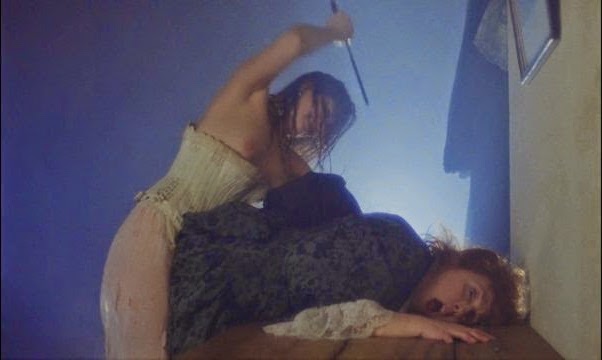
Strange Case of Dr Jekyll and Mr Hyde is a novel of dichotomies wherein each aspect of the book throws its counterparts into stark relief. Although novelist Robert Louis Stevenson’s novel pre-dates the works of Sigmund Freud, it never the less exemplifies many of Freud’s observations and psychological theories. The popularity and enduring relevance of Strange Case of Dr Jekyll and Mr Hyde has ensured its numerous film adaptations, though few filmmakers have been as suited to adapt the text as Walerian Borowczyk.
Borowczyk’s re-telling of Stevenson’s novel, Docteur Jekyll et les femmes (1981), follows a Freudian reading of the text executed to maximalist proportions. Borowczyk mines the thesis of Stevenson’s work utilizing the trappings of the Hammer Horror film, the slasher film, and the pornographic bodice ripper as his tools to excavate a uniquely Freudian psycho-sexual nightmare.
At its foundation Docteur Jekyll et les femmes re-imagines Strange Case of Dr Jekyll and Mr Hyde as a home invasion narrative. However, in Borowczyk’s dramatic economy, the home of Dr. Jekyll (Udo Kier) is a representation of that character’s psyche. Mr. Hyde invades the physical spaces of the house just as he invades the body, the flesh of Dr. Jekyll. Like the mind, the Jekyll home is an impossible to map labyrinth whose only discernible logic to its form is a kind of dream logic.
The physical transformation from Jekyll to Hyde is equally symbolic in so far as Hyde’s giant, killer, bright red penis is concerned. This cartoonish appendage is literally a murder weapon. Yet, it is also an expression of Hyde’s amplification of Jekyll’s id. Borowczyk only allows this penis to be glimpsed in action occasionally, focusing instead on the human debris it leaves in its wake. In addition, it is notable that Hyde’s appetites, as demonstrated by his victims’ gender, is not exclusively heterosexual.
Less obvious and darkly humorous than the bright red penis are the poison arrows from Africa. This phallic instrument of death represents not just sexual aggression or violence, but the cruelties of imperialist cultural genocide and appropriation. The arrows are a token of imperial conquest given as a gift and employed for murder where the penis has quite literally failed. It’s a collection of combustible meanings to this object that has always been typical of Borowczyk’s films.
The orgy of violence, panic, and sexual mania in Borowczyk’s claustrophobic adaptation of Strange Case of Dr Jekyll and Mr Hyde places it in the same thematic vein of Borowczyk’s work as Contes immoraux (1973) and Interno di un convento (1977). Each of these films attack the antiquated morality of Western European culture by way of their temporal narrative setting. These films equate spiritual liberty with sexual decadence suggesting that pornography is the ultimate art form of revolutions.
And like Contes immoraux or Blanche (1972), Docteur Jekyll et les femmes condenses the international political stage to the intimate confines of a single space. Jekyll’s home is a reflection of his interiority but it is populated by archetypal characters derivative of European literary traditions. For Borowczyk the psychology of the individual is the point of genesis for the politics of the masses. This stratagem taps into the dichotomies inherent in Stevenson’s narrative, offering an external reflection of dueling internal impulses.
All of these themes are unified by Borowczyk’s signature image compositions. The images that make up Docteur Jekyll et les femmes are cloudy, dark and Gothic with a special fetishistic attention paid to those objects with a traditional gender association. Docteur Jekyll et les femmes looks like late nineteenth century photography imbued with cool colors and punctuated by crimson reds. Bodies, objects, and rooms are all subtly eroticized as Borowczyk’s camera caresses characters and spaces with lingering close-ups and slow moving, hand held pans.
Few horror films of the eighties perfectly link thematic tone to image the way Borowczyk does in Docteur Jekyll et les femmes. Only The Hunger (1983) and Possession (1981) equal the cinematographic beauty and precision of Docteur Jekyll et les femmes. Docteur Jekyll et les femmes also has the distinction of being the most inspired and effective adaptation of Robert Louis Stevenson’s novel ever put to film. Docteur Jekyll et les femmes is one of Borowczyk’s true masterpieces and it demands to be seen.
